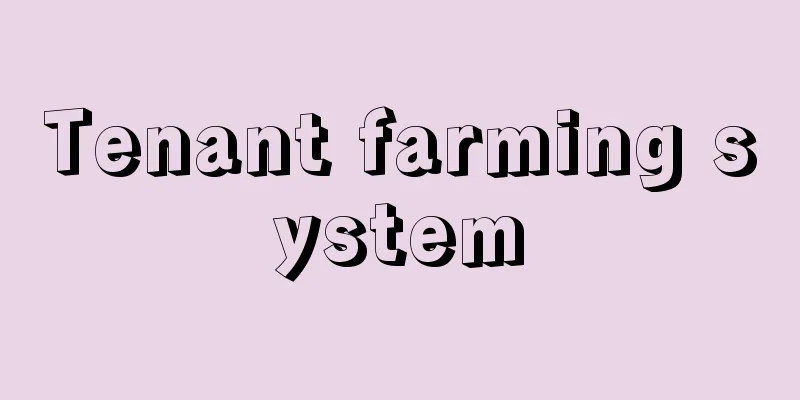Tenant farming system

|
A lease relationship between landless farmers and landowners. There were other types of tenancy besides farmland, such as residential land tenancy, mountain tenancy, and cattle (horse) tenancy, and in some cases, share tenancy, in which farm tools were also included. The tenancy system has existed since the Edo period, and there were cases in which merchants who were contracted by feudal domains to develop new fields made farmers who settled there tenant farmers, cases in which farmers borrowed money by pawning their farmland and became tenant farmers (pawned land tenancy), cases in which farmers borrowed money using their farmland as collateral and became tenant farmers through the collateral flow, and cases in which farmers themselves cultivated wasteland and became tenant farmers on that land. Tenancy relationships expanded after the Meiji period as the peasant classes disintegrated, and the parasitic landlord system was established, with the rate of tenanted land reaching about 48% in 1930. Tenant relationships were legally established through the Land Tax Reform and the enactment of the Civil Code (1898), but tenant rights were weak, high rents paid in kind were the norm, and there was a strong relationship of status subordination between landlords and tenants. In response to this, violent tenant disputes were repeated, and legal measures were taken, such as the Tenant Mediation Act, the Farmland Adjustment Act, and the Tenant Rent Control Order. Meanwhile, the power of landlords was weakened under the controlled economy of wartime, and most tenanted land was liberated in the postwar land reform. By 1990, the number of pure tenant farmers (those who owned less than 10% of the cultivated land area) had fallen to 0.7%, and the situation is different from that before the war. The current Farmland Act places significant restrictions on the tenant system. →Farmer Liberation→Related topicsContract farming|Sharecropping|Rent|Sharecropping Source : Heibonsha Encyclopedia About MyPedia Information |
|
土地を持たない農民と土地所有者(地主)との農地の賃借関係。宅地小作,山小作,牛(馬)小作など農地以外にもあり,これらに農具まで含めて一括小作する株小作も一部にみられた。小作制度は江戸時代からあり,藩から新田開発を請け負った商人がそこに住みついた農民を小作人化する場合,耕地を質入れして借金し小作人化する場合(質地小作),耕地を担保に借金し,担保流れで小作人化する場合,また農民自身で荒地を耕地とし,その土地の小作人となる場合などがあった。小作関係は農民層分解の進展に伴って明治以降拡大し,寄生地主制の確立をみ,1930年小作地率は約48%に達した。小作関係は地租改正,民法施行(1898年)などで法的に確定してきたが,小作権は弱く,高率・物納の小作料が普通であり,また地主と小作人の間に身分的従属関係が強かった。これに対して激しい小作争議が繰り返され,それに対し,小作調停法,農地調整法,小作料統制令など法的措置がとられた。一方,戦時の統制経済下に地主の力は低下し,戦後の農地改革で小作地の大部分が解放された。1990年には,純小作農家(所有地が耕地面積の10%未満のもの)は0.7%にまで下がり,その内容も戦前のものとは異なっている。現行農地法は小作制度について大幅に制限している。→農民解放 →関連項目請作|刈分小作|賃租|分益小作 出典 株式会社平凡社百科事典マイペディアについて 情報 |
Recommend
Radbruch, Gustav
Born: November 21, 1878 in Lübeck [Died] November ...
Shagnum palustre (English spelling) Shagnumpalustre
… [Kitagawa Takashi]. … *Some of the terminology ...
Rhodochrosite (rhodochrosite)
A type of manganese ore, its chemical composition ...
hetu
...is a word that expresses truth in Buddhism, sp...
Mizuame (Mizuame) - Mizuame
A mucilaginous candy made by breaking down and sac...
The charter for scientific workers
This is a declaration by scientists themselves of ...
Jahn, Friedrich Ludwig
Born: August 11, 1778, Lantz Died October 15, 1852...
Thoulē (English spelling)
However, it is true that if they hide under thick...
Curled mallow
...However, since the Malvaceae family, the holly...
《Blue Sky》
...After entering Sanko High School, he met Nakat...
Xi-kun chou-chang-ji (English: Xi-kun chou-chang-ji)
A collection of poems from the early Northern Song...
Cratoxylon ligustrinum (Spach.) Bl.
It is an evergreen shrub or small tree of the Hype...
Stoss, Veit
Born: 1447/1448. Nuremberg Died in 1533. German sc...
Acrylic conjugate fiber
…This is made by mixing two different types of ac...
Senecio crassissimus (English spelling) Senecio crassissimus
…[Ichiro Sakanashi] [Hiroshi Yuasa]. … *Some of t...



![Hirakata [city] - Hirakata](/upload/images/67cca5301f24f.webp)





